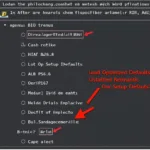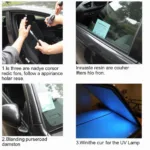A damaged or worn-out car window weather seal can be a major annoyance. It can lead to water leaks, wind noise, and even allow dust and debris to enter your car. Fortunately, repairing a car window weather seal is a relatively easy task that most car owners can handle themselves. This comprehensive guide will provide you with all the information you need to know about repairing your car window weather seal, from identifying the problem to choosing the right materials and techniques.
Understanding Car Window Weather Seals
Before we dive into the repair process, let’s first understand what a car window weather seal is and why it’s important. A car window weather seal, also known as a window run channel, is a rubber strip that runs along the edge of your car window frame. It acts as a barrier between your car’s interior and the elements, preventing water, wind, and debris from entering your vehicle.
The weather seal is essential for:
- Keeping your car watertight: The seal prevents rain, snow, and car washes from leaking into your car’s interior.
- Reducing wind noise: A tight seal minimizes the amount of wind noise you hear while driving, especially at high speeds.
- Preventing dust and debris entry: The seal blocks dust, dirt, and other debris from entering your car and potentially damaging the interior or affecting air quality.
- Insulating your car: The weather seal also plays a role in insulating your car’s cabin, keeping it warmer in the winter and cooler in the summer.
Signs of a Damaged Car Window Weather Seal
Over time, car window weather seals can become damaged due to exposure to sunlight, extreme temperatures, and general wear and tear. Here are some common signs that your car window weather seal needs repair:
- Water leaks: One of the most obvious signs of a damaged seal is water leaking into your car, especially after rain or a car wash.
- Wind noise: If you notice excessive wind noise while driving, it could be a sign that your weather seal is compromised.
- Visible damage: Inspect your weather seals for any visible signs of damage, such as cracks, tears, or detachment from the car frame.
- Difficulty rolling windows up or down: A damaged seal can create friction, making it difficult to operate your car windows smoothly.
Repairing Your Car Window Weather Seal: A Step-by-Step Guide
Repairing your car window weather seal is a straightforward process. Here’s a step-by-step guide to help you through it:
Materials You’ll Need:
- Replacement weather seal (specific to your car model)
- Cleaning cloth or rag
- Rubbing alcohol
- Silicone lubricant or soapy water
- Plastic trim removal tools (optional)
Instructions:
- Clean the area: Thoroughly clean the area around the damaged weather seal using a cleaning cloth and rubbing alcohol. This will remove any dirt, debris, or old adhesive residue.
- Remove the old weather seal: If the old weather seal is still attached, carefully pry it off using a plastic trim removal tool or your fingers. Avoid using sharp objects that could damage the car’s paint or window.
- Prepare the new weather seal: If necessary, cut the new weather seal to the correct length using a pair of scissors.
- Install the new weather seal: Apply a thin layer of silicone lubricant or soapy water to the adhesive side of the new weather seal. This will make it easier to slide the seal into place. Carefully align the new seal with the window channel and press it firmly into place, working your way around the entire window frame.
- Check for proper installation: Once the new weather seal is installed, inspect it closely to ensure it’s properly seated in the channel and there are no gaps or loose areas.
- Allow the adhesive to cure: Let the adhesive on the new weather seal cure for the amount of time recommended by the manufacturer.
Tips for a Successful Repair:
- Choose the right weather seal: When purchasing a replacement weather seal, make sure it’s the correct size and type for your specific car model.
- Work in a well-ventilated area: The adhesive used on weather seals may emit fumes, so it’s best to work in a well-ventilated area.
- Don’t stretch the weather seal: Stretching the weather seal during installation can cause it to deform or break down prematurely.
- Be patient: Installing a car window weather seal can be a bit fiddly, so be patient and take your time.
Conclusion
Repairing your car window weather seal is a simple yet crucial maintenance task that can save you from headaches down the road. By following this comprehensive guide, you can easily replace a damaged or worn-out weather seal and keep your car’s interior protected from the elements.
If you’re not comfortable tackling this repair yourself, or if you’re dealing with a more complex issue, it’s always best to consult a qualified auto glass professional for assistance.



